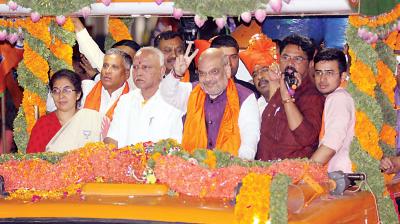
Amit Shah kills the dissent in Bangalore South
The discord in Bangalore South constituency over the denial of the party ticket to Tejaswini Ananth Kumar, appears to have been papered over for now, hours before the arrival of BJP National President Amit Shah in the city for a massive road show with the party...
read more
WhatsApp makes group chats more secure, gives users more control
e-Paper | Sunday Chronicle Auto Refresh | Corporate Insolvency Resolution Process LOK SABHA ELECTIONS 2019: INDIA DECIDES Wednesday, Apr 03, 2019 | Last Update : 04:55 PM IST Elections 2019 Nation World South Entertainment Sports Technology Lifestyle Gallery Business...
read more
BJP lawmaker makes remark on Priyanka Gandhi
Ahead of Lok Sabha elections, a BJP leader campaigning in Uttar Pradesh’s Meerut is the latest to raise the outrage. In reference to Congress leader Priyanka Gandhi, BJP’s Jayakaran Gupta said “skirt wali bai” in what was interpreted as a reference to Congress leader...
read moreDonald Trump mocks Joe Biden over improper behaviour
US President Donald Trump took a shot on Tuesday at former Vice-President Joe Biden, a possible Democratic rival in the 2020 race for the White House, mocking him over allegations of unwanted physical contact with women. In a speech to a fundraising dinner for the...
read more
India sends note verbale to Pak, seeks access to Kulbhushan, free 10 prisoners
India on Tuesday sent a note verbale to Pakistan , urging it to make necessary arrangements for an immediate release and repatriation of 10 Indian prisoners who had completed the prison sentence in Pakistani jails. India has also made a fresh demand seeking consular...
read more
Mamata alters schedule to have last word to take on PM Modi in Bengal
Prime Minister Narendra Modi will launch his Lok Sabha poll campaign in West Bengal on Wednesday with two rallies - one in Siliguri and second at the Brigade Parade Ground in Kolkata. West Bengal has 42 seats, of which the BJP is eyeing more than 20. Giving a good...
read more
Mamata Banerjee ‘speed breaker’ in path of development: PM in Bengal
Launching a torpedo on Trinamul Congress supremo Mamata Banerjee in her home turf, Prime Minister Narendra Modi on Wednesday called the West Bengal chief minister a "speed breaker" on his development projects. He observated that Ms Banerjee's "boat has started...
read more
Zuzana Caputova is Slovakia first female president
Vocal government critic and anti-corruption activist Zuzana Caputova will become Slovakia’s first female president after provisional results showed her winning Saturday’s run-off election. Environmental lawyer Caputova got 58.40 per cent of the ballot while EU energy...
read more
Terrorists tapped UK tax fraud cash
A British Asian gang of fraudsters may have been involved in misusing billions of pounds of British taxpayers’ money to fund terrorist networks in Pakistan and Afgha-nistan, claims a UK media probe based on police and intelligence files. The gang, based in London,...
read more
Cong trying to defame Hindus by giving them terror tag: Amit Shah in Odisha
BJP president Amit Shah Monday lashed out at the Congress, accusing the grand old party of trying to "defame" Hindus by giving them a terror tag. "Rahul (Gandhi) Baba's party attempted to link Hindu community with terrorism. It was a bid to defame Hindus across the...
read moreScientists explore anti-cancer properties of traditional Siddha medicine, Pattu Karuppu
The allopathic system of medicine that treats symptoms of diseases using drugs came into existence in the 19th century. Before that, traditional medicines were common in many Asian countries, including India. A common drawback of allopathic medications is their undesired side effects caused by the adverse reactions of specific drug compounds with parts of our body. This has now rekindled interests among scientists in many traditional forms of medicine which are known to have no side effects. In one such study, researchers from the Manipal Institute of Technology, Manipal, Karnataka, and Anna University, Chennai, have evaluated the anti-cancer properties of Pattu Karuppu, a traditional Siddha medicine.
The Siddha system of medicine has its origin in Tamil Nadu and is similar to Ayurveda where extracts of different plants are used to treat various diseases. Pattu Karuppu is a mercury-based Siddha medicine prepared by the combination of acidic and alkaline substances and is rich in mercuric sulphide (HgS). While mercury is well-known for its curative effects, sulphur neutralises the toxicity of the medicine and makes it more effective.
While Pattu Karuppu is used to treat pain during menstruation (dysmenorrhoea), the absence of menstrual cycle (amenorrhoea) and delirium, its anticancer properties have not yet been explored. In this study, for the first time, the researchers look into the physical and chemical properties of this formulation and evaluate its effects on healthy cells.
The researchers examined a sample of Pattu Karuppu under an electron microscope and found that it contains nanoparticles with an average size of 20-80 nanometers. These come together and form a ‘broccoli-like’ structure. A chemical analysis of the compound showed that it mainly contains carbon and oxygen, with traces of mercury, arsenic and sulphur. “The sample was found to have stable and spherical (porous) particles with size ranges between 20-80 nanometres. The negatively charged, nanosize and relatively high surface area of the particles were used to evaluate its biological action”, say the authors.
The researchers then tested different concentrations of the formulation on cell lines in labs. They observed that the formulation could inhibit the growth of cancerous cells. To determine the ‘safe’ concentrations of Pattu Karuppu, they tested it on zebrafish. They observed that at high concentrations, the zebrafish developed problems with the rate of heartbeat (arrhythmias) and clotting of the blood cells in the heart. The results confirmed that a concentration of 100μg/ml was the safest, a finding that differentiates Pattu Karuppu from other toxic mercurials.
The study promises new hope for cancer patients whose life is bogged down by the side effects of radiation therapy and chemotherapy. As a next step, the authors plan to conduct similar studies on mouse models that could pave the way for effective anticancer drugs.
Asteroid 2010 WC9 to fly by Earth on May 15: Report
Space rock “Asteroid 2010 WC9” will have a near-Earth encounter, about half the lunar distance, on Tuesday, media reports said.The asteroid measures from 60 to 130 meters and moves at a speed of more than 28,000 miles per hour, WeekFacts.com reported late on Saturday.
Asteroid 2010 WC9 was “lost” and then found. The Catalina Sky Survey in Arizona first detected it on November 30, 2010, and astronomers watched it until December 1, when it became too faint to see.
The rock has completed its orbit and now returns to Earth eight years later.
At 11.05 p.m. on Tuesday, Asteroid 2010 WC9 will make its closest approach only 0.53 lunar distances (126.419 miles) from Earth.According to NASA’s Jet Propulsion Laboratory, this is the closest it will come in 300 years, the report said.
People can watch the spectacle on the Internet and the observatories of Northolt Branch in London will broadcast it live.
“We plan to broadcast this asteroid to our Facebook page if the weather forecast remains positive,” Guy Wells of the observatory was quoted as saying.
“The broadcast will last less than 25 minutes, since the asteroid will cross our field of view during this time period. The asteroid will move pretty fast (30 seconds of arc per minute).
“Our display will be updated every five seconds. We, of course, collect astrometric data while this happens, but the movement of the asteroid will occur every five seconds,” said Wells.
Jurassic fossil shows missing link in crocodile family tree
Researchers have found a “missing link” from a 180 million-year-old fossil that sheds light on how some ancient crocodiles evolved into dolphin-like animals.The fossil named Magyarosuchus fitosi in honour of the amateur collector who discovered it, Attila Fitos, was unearthed on a mountain range in north-west Hungary in 1996 and stored in a museum in Budapest.
The species featuring a large portion of backbone is nearly five metres long and had large, pointed teeth for grasping prey. It was one of the largest coastal predators of the Jurassic Period.
It also shares key body features seen in two distinct families of prehistoric crocodiles.
Besides being heavily armoured, the species also had a tail fin, suggesting it is a missing link in the family tree of crocodiles, the researchers noted, in the paper published in the journal PeerJ.
“This fossil provides a unique insight into how crocodiles began evolving into dolphin and killer whale-like forms more than 180 million years ago,” said Mark Young, of the University of Edinburgh’s School of GeoSciences in Britain.
“The presence of both bony armour and a tail fin highlights the remarkable diversity of Jurassic-era crocodiles.”The specimen was identified as a new species based on the discovery of an odd-looking vertebra that formed part of its tail fin.
Some Jurassic-era crocodiles had bony armour on their backs and bellies and limbs adapted for walking on land. Another group had tail fins and flippers but did not have armour, the researchers said.








